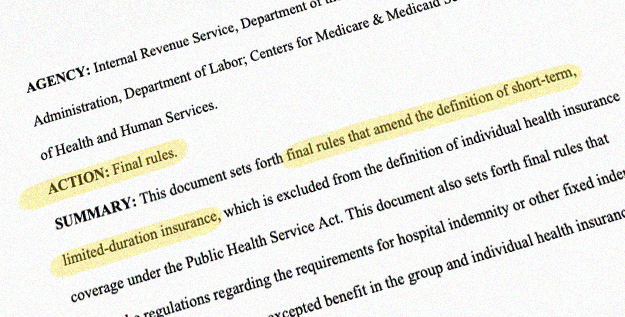
In this edition
- COVID-19 special enrollment periods in NY, MD end next Wednesday
- Pennsylvania enacts law requiring health insurers to cover additional breast cancer screening for higher-risk women
- Colorado enacts legislation to make individual-market coverage more affordable
- Proposed 2021 rate changes for New Mexico individual market mostly modest except for CO-OP
- Proposed 2021 rate changes for Michigan exchange insurers range from 2% decrease to 6% increase
- Insurers in Hawaii individual market have proposed average rate decreases for 2021, for the second year in a row
- Five insurers will offer public option plans in Washington for 2021, but only in 20 of state’s 39 counties
- More than enough signatures submitted to get Arizona healthcare reform initiative on the ballot, but they must still be verified
COVID-19 special enrollment periods in NY, MD end next Wednesday
Uninsured residents in several states can still enroll in health coverage without a qualifying event, via special enrollment periods designed to address the COVID-19 pandemic. But those windows end next Wednesday in Maryland and New York, so uninsured residents in those states have only one week left to sign up for ACA-compliant health coverage. After the special enrollment periods end, residents will need a qualifying event to purchase coverage before open enrollment starts again in November.
Pennsylvania enacts law requiring health insurers to cover additional breast cancer screening for higher-risk women
Under the Affordable Care Act’s preventive care requirements – as well as Pennsylvania’s existing laws – health insurers are required to pay for screening mammograms. But some women need additional screening with MRIs or ultrasound, including women with extremely dense breast tissue and women who are considered to have a higher risk for breast cancer due to family or personal history, or BRCA1/BRCA2 gene mutations. Pennsylvania has enacted SB595, which requires health insurers to cover these additional screening tests for women in those categories. Unlike screening mammograms, which must be covered in full (ie, with no deductible, copay, or coinsurance) under federal law, health insurers in Pennsylvania will still be able to impose cost sharing for screening MRIs and ultrasounds.
Colorado enacts legislation to make individual-market coverage more affordable
Colorado has enacted SB215, which is designed to make health insurance more affordable for Americans who buy their own coverage. The law will extend funding for Colorado’s existing reinsurance program, which makes coverage more affordable for people who don’t get premium subsidies under the ACA. But as of 2022, it will also provide state-based funding to make coverage more affordable for people who do get ACA premium subsidies. And as of 2023, it will provide state-funded subsidies to make coverage more affordable for residents with modest incomes who aren’t eligible for premium subsidies due to the family glitch or immigration status.
Colorado has also enacted HB1236, which will create an “easy enrollment” program, similar to the one that Maryland debuted this year. Starting in 2022, Colorado residents will be able to check a box on their tax returns, indicating that they want the state to use their financial information to determine whether they might be eligible for free or low-cost health coverage through Medicaid or the state-run health insurance exchange. Eligible residents would then be given a special enrollment period during which they could sign up for coverage.
Proposed 2021 rate changes for New Mexico individual market mostly modest except for CO-OP
New Mexico’s four individual-market insurers have filed proposed rates for 2021. Three of them are requesting fairly modest rate changes, but New Mexico Health Connections (an ACA-created CO-OP) has proposed an average rate increase of nearly 32 percent. It’s worth noting, however, that the CO-OP proposed a similar rate increase last year, but ended up increasing rates by less than 2 percent after the rate review process was completed.
Proposed 2021 rate changes for Michigan exchange insurers range from 2% decrease to 6% increase
Michigan’s nine exchange insurers have proposed average rate changes for 2021 that vary from a 2 percent decrease to a 6 percent increase. Across the full individual market (including two insurers that only offer plans outside the exchange), the average proposed rate change is an increase of just over 1 percent. Only three of the insurers incorporated a COVID-19 factor into their proposed rate increases for 2021, although the Michigan Department of Insurance and Financial Services published a bulletin in May clarifying that insurers would have to thoroughly document and justify any proposed rate adjustments based on COVID-19.
Hawaii insurers propose small rate decrease for 2021, after decreasing rates in 2020 as well
Like many other states, Hawaii’s individual market saw sharp premium increases in 2017 and 2018, but rates have been much more stable since then. Premiums declined in 2020, and the state’s two insurers have proposed another round of average rate decreases for 2021. HMSA is proposing an average decrease of about 2 percent, while Kaiser is proposing an average decrease of about 1 percent.
Five insurers will offer public option plans in Washington for 2021, but only in 20 of state’s 39 counties
Washington State will be the first to offer public option health plans starting this fall, for coverage effective in 2021. Of the 15 insurers that plan to offer individual market coverage in Washington, five will offer public option plans. The plans will be available in 20 of the state’s 39 counties, although they could become more widely available in future years.
More than enough signatures submitted to get Arizona health care reform initiative on the ballot, but they must still be verified
Last summer, we told you about a ballot initiative in Arizona that would increase the minimum wage for healthcare workers, end surprise balance billing, and codify several Affordable Care Act provisions into state law. At the time, advocates were starting to gather signatures, which had to be submitted by July 2, 2020. More than 425,000 signatures were submitted last week – far more than the 238,000 required – although the signatures now have to be verified in order for the measure to appear on the November 2020 ballot in Arizona.
Louise Norris is an individual health insurance broker who has been writing about health insurance and health reform since 2006. She has written dozens of opinions and educational pieces about the Affordable Care Act for healthinsurance.org.









